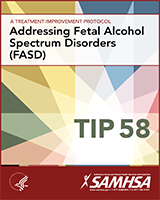NCBI Bookshelf. A service of the National Library of Medicine, National Institutes of Health.
Center for Substance Abuse Prevention (US). Addressing Fetal Alcohol Spectrum Disorders (FASD). Rockville (MD): Substance Abuse and Mental Health Services Administration (US); 2014. (Treatment Improvement Protocol (TIP) Series, No. 58.)
Fetal Alcohol Syndrome (FAS) is a permanent birth defect syndrome caused by maternal consumption of alcohol during pregnancy. Almost four decades have passed since the term FAS was first coined. The condition is now recognized as a spectrum of disorders: Fetal Alcohol Spectrum Disorders (FASD). Substantial progress has been made in developing specific criteria for delineating diagnoses under the umbrella of FASD. In the 14 years since the publication of the seminal report on FAS by the Institute of Medicine in 1996, clear consensus has been reached on two fundamental issues: 1) an FASD diagnostic evaluation is best conducted by a team of professionals from multiple disciplines (medicine, psychology, speech-language, occupational therapy) and 2) the team should use rigorously case-defined and validated FASD diagnostic guidelines.
In 2011, Dr. Susan Astley wrote a chapter on Diagnosing FASD in a book entitled Prenatal Alcohol Use and Fetal Alcohol Spectrum Disorders: Diagnosis, Assessment and New Directions in Research and Multimodal Treatment (Astley, 2011). This chapter provided a brief overview of the discovery of FASD, diagnostic challenges, how diagnostic guidelines and clinical models have evolved over time to address these challenges, and how new technology may influence the future of FASD diagnosis. The tables below come from that chapter, and provide a side-by-side comparison of the five most commonly used diagnostic guidelines for forms of FASD; the 4-Digit Diagnostic Code (Astley, 2004b), the guidelines developed by the Centers for Disease Control and Prevention (Bertrand et al., 2004), the Canadian guidelines (Chudley et al., 2005), the revised guidelines of the Institute of Medicine (IOM) (Hoyme et al., 2005), and the original IOM guidelines (Stratton et al., 1996). Table 1 compares diagnostic criteria for FAS; Table 2, pFAS; Table 3, ARND; and Table 4, ARBD. These tables are reprinted here with the permission of the author.
Table 1
FAS Diagnostic Criteria: Comparison Across the Five Most Current FASD Diagnostic Guidelines.
Table 2
Partial FAS Diagnostic Criteria: Comparison Across the Five Most Current FASD Diagnostic Guidelines.
Table 3
ARND (or its equivalent: Static Encephalopathy/Alcohol Exposed or Neurobehavioral Disorder/Alcohol Exposed) Diagnostic Criteria: Comparison Across the Five Most Current FASD Diagnostic Guidelines.
Table 4
ARBD Diagnostic Criteria: Comparison Across the Five Most Current FASD Diagnostic Guidelines.
It is important to note that, for the purposes of this Appendix, the 4-Digit Diagnostic Code has been translated, as best as possible, into a text (rather than numeric) format. This was done to facilitate comparison to the other guidelines that publish their diagnostic criteria in text format. Diagnostic teams should not use the textual translations of the 4-Digit Code presented in Tables 1-4 to derive a 4-Digit Code, but rather the numeric format presented in the Diagnostic Guide for Fetal Alcohol Spectrum Disorders: The 4-Digit Diagnostic Code, Third Edition (Astley, 2004a).
- Comparison of Current FASD Diagnostic Systems - Addressing Fetal Alcohol Spectru...Comparison of Current FASD Diagnostic Systems - Addressing Fetal Alcohol Spectrum Disorders (FASD)
Your browsing activity is empty.
Activity recording is turned off.
See more...
